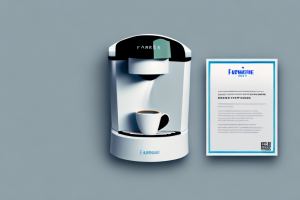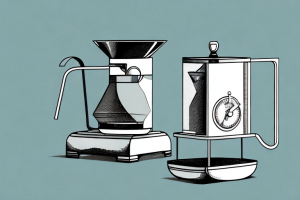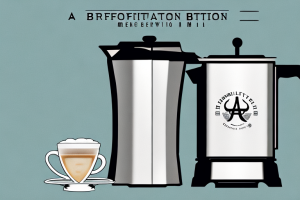How To Clean Mold From Coffee Maker

A coffee maker with visible mold on it
Are you a coffee lover who enjoys a freshly brewed cup every morning? If yes, then you must know that coffee makers are prone to developing mold if not cleaned regularly. Mold can not only affect the taste and quality of your coffee but also pose potential health risks. In this detailed guide, we will discuss why it’s essential to clean your coffee maker regularly, common causes of mold, tools and supplies you need, step-by-step guide to cleaning, natural methods, and preventive measures to avoid mold growth. So, let’s get started.
Why It’s Important To Clean Your Coffee Maker Regularly
Like any other appliance used for food and drinks, coffee makers can harbor bacteria and mold if not cleaned regularly. Mold grows in a moist environment, and the coffee maker’s warm, humid and dark interior is an ideal breeding ground for mold and bacteria. If you don’t clean your coffee maker, the mold spores can spread to the coffee grounds, water reservoir, and coffee pot and contaminate your coffee. Moldy coffee can cause stomach problems, respiratory issues, and allergies. Therefore, it’s crucial to clean your coffee maker frequently as a preventive measure to maintain the hygiene and quality of your coffee.
Additionally, cleaning your coffee maker regularly can also improve the taste of your coffee. Over time, mineral deposits from the water can build up in the coffee maker, affecting the flavor of your coffee. By cleaning your coffee maker, you can remove these deposits and ensure that your coffee tastes fresh and delicious every time. Furthermore, a clean coffee maker can also extend the lifespan of your appliance, saving you money in the long run. So, make sure to add cleaning your coffee maker to your regular cleaning routine to enjoy a better cup of coffee and a healthier home.
Common Causes Of Mold In Coffee Makers
Various factors can lead to mold growth in coffee makers. These include:
- Not cleaning the coffee maker after each use
- Leaving water or coffee inside the machine for longer durations
- Using tap water that contains impurities
- Using old or expired coffee grounds
- Storing the coffee maker in a damp or moist area
In addition to the above factors, using a coffee maker with a built-in water reservoir can also contribute to mold growth. The stagnant water in the reservoir can become a breeding ground for mold if not cleaned regularly. It is important to follow the manufacturer’s instructions for cleaning and maintenance to prevent mold growth and ensure the longevity of your coffee maker.
Tools And Supplies You Will Need To Clean Your Coffee Maker
Before cleaning your coffee maker, ensure you have the following items:
- Vinegar or Lemon Juice
- Baking Soda
- Clean Water
- Scrub Brush or Toothbrush
- Microfiber Cloth
It is important to note that not all coffee makers are created equal, and some may require additional tools or supplies for proper cleaning. For example, if your coffee maker has a built-in grinder, you may need to use a specialized cleaning brush to remove any leftover coffee grounds. Additionally, if your coffee maker has a water filter, you may need to replace it periodically to ensure that your coffee is brewed with clean, fresh water. Always refer to your coffee maker’s user manual for specific cleaning instructions and recommendations.
Step-By-Step Guide To Cleaning Your Coffee Maker
Here’s how you can clean your coffee maker thoroughly:
Step 1: Empty the Coffee Maker
Start by unplugging the machine and emptying the coffee pot and the water reservoir. Discard any remaining coffee or water and ensure the coffee maker is cool before beginning the cleaning process.
Step 2: Prepare the Cleaning Solution
Mix equal parts of vinegar and water or lemon juice and water in the water reservoir. Alternatively, you can use baking soda to clean your coffee maker. Add one tablespoon of baking soda to a cup of warm water, mix well, and pour the solution into the water reservoir. Don’t use both vinegar/lemon juice and baking soda together as it can cause a reaction and damage the appliance.
Step 3: Run The Machine
Place a clean paper filter in the coffee basket and turn the coffee maker on. Let the machine brew the solution until half of it is in the coffee pot, then turn it off and let it sit for 30 minutes.
Step 4: Rinse The Machine
After 30 minutes, turn the coffee maker on again, allowing the remaining cleaning solution to brew. Discard the solution and repeat the process with clean water. Run the machine once with clean water to remove any residual vinegar or lemon juice and repeat with plain water. Repeat the process if necessary until there’s no trace of the cleaning solution or the odor of coffee.
Step 5: Wipe The Machine
Using a clean microfiber cloth, wipe the exterior and interior of the appliance to remove any dirt, mold, and stains. Pay special attention to the crevices, corners, and hard-to-reach areas. Use a scrub brush or toothbrush to clean the coffee basket, pot, and water reservoir if they have stubborn mold build-up.
Additional Information:
Regular cleaning of your coffee maker is essential to ensure that it functions properly and produces great-tasting coffee. However, there are a few things you should keep in mind to maintain your coffee maker’s longevity. Firstly, avoid using harsh chemicals or abrasive materials to clean your coffee maker as they can damage the appliance. Secondly, always rinse the coffee maker thoroughly after cleaning to remove any residual cleaning solution. Lastly, descale your coffee maker every three to six months to remove mineral buildup and ensure that it operates efficiently.
Additionally, if you notice any unusual smells or tastes in your coffee, it may be time to replace the coffee maker’s filter. Filters can become clogged with coffee grounds and oils, which can affect the taste and aroma of your coffee. Replace the filter regularly to ensure that your coffee maker produces the best possible coffee.
How To Disassemble Your Coffee Maker For Thorough Cleaning
If you want to clean your coffee maker more thoroughly, you can disassemble some parts and clean them. Follow these instructions:
Step 1: Review The Manual
Consult your coffee maker’s manual to learn how to disassemble it safely. If you don’t have the manual, look it up online or contact the manufacturer’s customer service.
Step 2: Disassemble The Coffee Maker
Unplug the machine and disconnect any removable parts such as the coffee basket, pot, and water reservoir. Some coffee makers have removable panels that allow easy access to the inner parts. You can disassemble as much as you feel comfortable and clean each part using the cleaning solution mentioned above.
Step 3: Reassemble The Coffee Maker
After cleaning, let the parts dry completely, and then reassemble them. Follow the instructions in the manual to ensure you assemble the machine correctly.
It’s important to note that not all coffee makers can be fully disassembled. Some models have parts that are not meant to be removed, and attempting to do so can damage the machine. If you’re unsure whether your coffee maker can be fully disassembled, consult the manual or contact the manufacturer’s customer service for guidance.
Natural Cleaning Methods For Removing Mold From Your Coffee Maker
If you prefer natural cleaning methods, you can use vinegar, lemon juice, or baking soda. These natural substances are safe, effective, and inexpensive.
Vinegar Method
Vinegar is a natural acid that can dissolve mold and bacteria. Fill the water reservoir with equal parts of water and vinegar. Run the machine without the coffee grounds, as you would while brewing coffee. Repeat the process a few times with water until there’s no vinegar smell.
Lemon Juice Method
Lemon juice is a natural acid that can kill off bacteria. Fill the water reservoir with water and add the juice of two lemons. Run the coffee maker once or twice to clean and rinse the machine.
Baking Soda Method
Baking soda is a natural abrasive that can scrub away mold and stains. Mix one tablespoon of baking soda with a cup of warm water and pour the solution into the water reservoir. Run the machine to allow the solution to move through the coffee maker and clean it. Rinse thoroughly with water.
It’s important to note that while natural cleaning methods can be effective, they may not completely remove all mold and bacteria. If you have a severe mold problem in your coffee maker, it’s best to consult a professional or replace the machine altogether. Additionally, it’s important to regularly clean your coffee maker to prevent mold growth in the first place.
Tips For Preventing Mold Growth In Your Coffee Maker
Preventing mold growth in your coffee maker is as important as cleaning it. Here are some tips:
- Clean the coffee maker after every use
- Use clean and filtered water
- Store the coffee maker in a dry and well-ventilated place
- Change the paper filter every time you brew coffee
- Limit the amount of coffee you brew and discard any unused coffee
Another important tip for preventing mold growth in your coffee maker is to descale it regularly. Over time, mineral deposits can build up in the machine, creating a breeding ground for mold and bacteria. To descale your coffee maker, mix equal parts water and white vinegar and run it through the machine. Then, run several cycles of clean water through the machine to rinse it out.
It’s also a good idea to take apart your coffee maker and clean all of its components periodically. This includes the carafe, filter basket, and any other removable parts. Use warm, soapy water and a scrub brush to clean these parts thoroughly, and then rinse them well and let them air dry before reassembling the machine.
How Often Should You Clean Your Coffee Maker?
You should clean your coffee maker every two weeks or every month, depending on how often you use it. If you use it daily, it’s advisable to clean it every two weeks. If you use it occasionally, once a month should suffice.
However, if you notice any unusual taste or smell in your coffee, it’s a sign that your coffee maker needs to be cleaned immediately. This could be due to the buildup of mineral deposits or mold inside the machine. In such cases, it’s recommended to clean your coffee maker thoroughly using a mixture of vinegar and water or a specialized cleaning solution.
How To Know When It’s Time To Replace Your Coffee Maker
If your coffee maker is old, outdated, or shows any signs of damage, it’s time to replace it. Other indications that it’s time to get a new coffee maker are:
- The machine is not brewing coffee correctly
- The coffee tastes odd or has a strange odor
- The machine leaks or makes unusual noise
- It takes longer than usual to brew coffee
- The machine has visible mold, rust, or mineral build-up
Another sign that it’s time to replace your coffee maker is if it doesn’t have the features you need. For example, if you’re someone who likes to make a large pot of coffee in the morning, but your current coffee maker only makes a single cup at a time, it might be time to upgrade to a larger machine. Similarly, if you’re someone who likes to have your coffee ready as soon as you wake up, but your current coffee maker takes too long to brew, you might want to consider getting a machine with a programmable timer.
It’s also important to consider the overall quality of your coffee maker. If you find that you’re having to replace your coffee maker every year or two, it might be worth investing in a higher-quality machine that will last longer. While these machines may be more expensive upfront, they can save you money in the long run by reducing the need for frequent replacements.
Conclusion
Knowing how to clean and maintain your coffee maker is vital to ensure the hygiene and quality of your coffee. Mold growth in coffee makers is a common occurrence that can pose potential health risks. Fortunately, cleaning your coffee maker is a simple task that you can do by yourself with basic supplies and natural substances. Follow our step-by-step guide to clean your coffee maker thoroughly and prevent mold growth. Remember to clean your coffee maker frequently and replace it when necessary.



